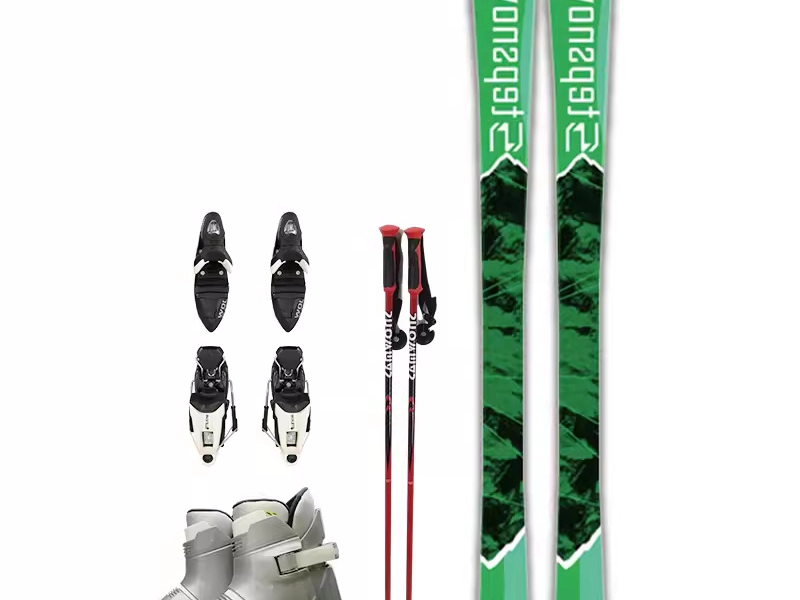Ski Waxing 101: Maintaining Your Equipment
You should have a scraper of some kind; metal is good for speed and accuracy; plastic is better for the bases; nylon or horsehair brushes are better still. Move from tip to tail of the ski and provide a reasonable pressure in overlapping strokes. You should also have a diamond file to handle burrs and a gummy stone to clean the edges from rust.
1. Organise the Foundation.

2. Inspect the margins.
 Generally speaking, you want to select wax suitable for the daily conditions. This increases the skis' lifetime and grips quality. Waxing the base helps to maintain its moisture as well.
Start by brushing the base numerous times as advised in Step 3 of this article (remember to remove the brakes first). This opens the ski's structure to improved wax absorption.
Then gently remove the thin wax layers from the base of your skis starting with a sharp plastic scraper. This should be done precisely to prevent changing the base's structure and gouging it.
Though it's easy to grab a file and smooth the side edges of your skis, this is a mistake. Dragging the file along your edge will remove tiny metal particles, therefore reducing the life of your edges.
Generally speaking, you want to select wax suitable for the daily conditions. This increases the skis' lifetime and grips quality. Waxing the base helps to maintain its moisture as well.
Start by brushing the base numerous times as advised in Step 3 of this article (remember to remove the brakes first). This opens the ski's structure to improved wax absorption.
Then gently remove the thin wax layers from the base of your skis starting with a sharp plastic scraper. This should be done precisely to prevent changing the base's structure and gouging it.
Though it's easy to grab a file and smooth the side edges of your skis, this is a mistake. Dragging the file along your edge will remove tiny metal particles, therefore reducing the life of your edges.
3. Examine the bindings.
 The technique basically consists in heating your iron to the advised temperature on the wax packaging. Like rusting a bike chain, if the iron begins burning it is too hot and you run the danger of ruining your base.
To open shop and begin going, a few simple tools are required:
You are ready to start waxing after you have your tools and a well-ventilated work area (since breathing clouds of burning wax fumes may rapidly detour you off the road to wellness). Starting with a universal temperature rub-on wax is the finest place. Choose the wax that best fits the present air and snow conditions of your skis; the temperature ranges shown on the wax packet are acceptable references. Over the whole base, crayon a thin coating of wax; use the roto-cork to smooth it in; then, brush with a nylon brush. Depending on your terrain and snow conditions, repeat as needed—probably every five to seven ski days.
The technique basically consists in heating your iron to the advised temperature on the wax packaging. Like rusting a bike chain, if the iron begins burning it is too hot and you run the danger of ruining your base.
To open shop and begin going, a few simple tools are required:
You are ready to start waxing after you have your tools and a well-ventilated work area (since breathing clouds of burning wax fumes may rapidly detour you off the road to wellness). Starting with a universal temperature rub-on wax is the finest place. Choose the wax that best fits the present air and snow conditions of your skis; the temperature ranges shown on the wax packet are acceptable references. Over the whole base, crayon a thin coating of wax; use the roto-cork to smooth it in; then, brush with a nylon brush. Depending on your terrain and snow conditions, repeat as needed—probably every five to seven ski days.
4. Look for Damage
 Having an experienced skier check your equipment at least once season is a smart idea. They can hunt for and fix edge rust or basic damage.
Since a decent ski might be costly, it's wise to ensure everything is in operating order.
Should you observe indications of base burn or other damage, you can scrape away any contaminants using an iron set to a low temperature—the maximum temperature stated on the iron. Depending on the situation, you might then reapply klister or soft hydrocarbon wax.
Since they have a greater maximum temperature and can melt the bases of your equipment (not good), be sure you use a clothing iron made for waxing instead of an ordinary home iron or an electric one. Apply the wax with a cloth; rub it in; then, using a Thermo Pad, buff.
Having an experienced skier check your equipment at least once season is a smart idea. They can hunt for and fix edge rust or basic damage.
Since a decent ski might be costly, it's wise to ensure everything is in operating order.
Should you observe indications of base burn or other damage, you can scrape away any contaminants using an iron set to a low temperature—the maximum temperature stated on the iron. Depending on the situation, you might then reapply klister or soft hydrocarbon wax.
Since they have a greater maximum temperature and can melt the bases of your equipment (not good), be sure you use a clothing iron made for waxing instead of an ordinary home iron or an electric one. Apply the wax with a cloth; rub it in; then, using a Thermo Pad, buff.








